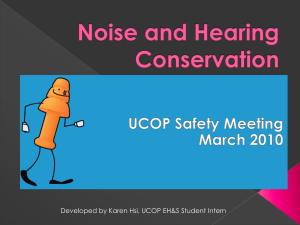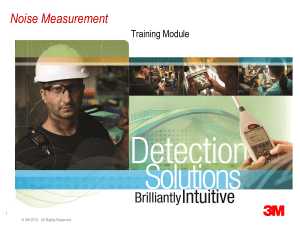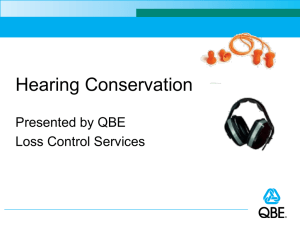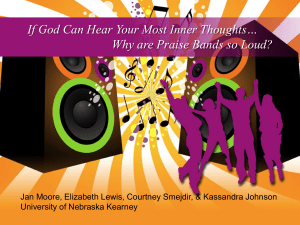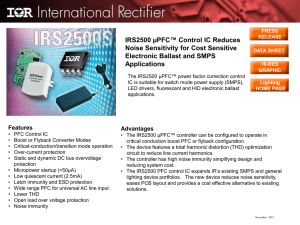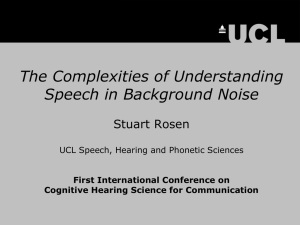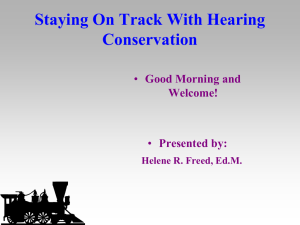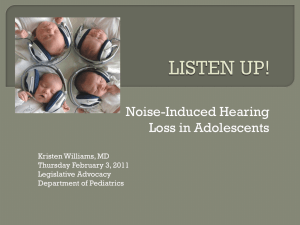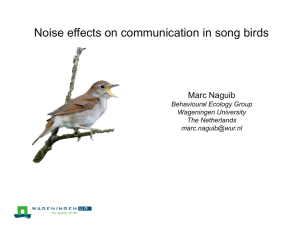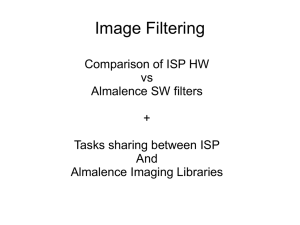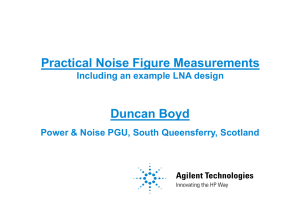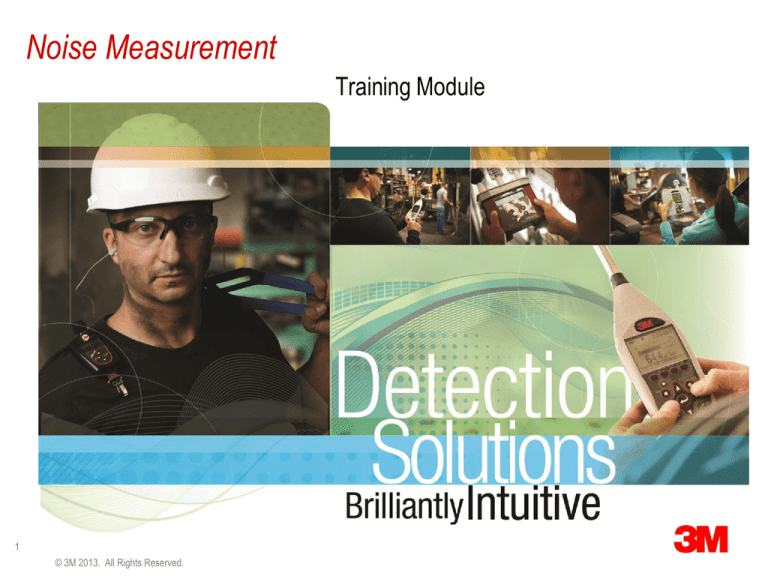
Noise Measurement
Training Module
1
© 3M 2013. All Rights Reserved.
Table of Contents
Physics of Sound (Hearing loss, terminology)
OSHA (Regulations)
Sound Level Meters
Noise Dosimetry
2
© 3M 2013. All Rights Reserved.
Noise Measurement and Dosimetry
Learning Objectives
Explain sound pressure level, frequency & respective units of
measure
Describe level average, time weighted average & dose
Explanation of criterion, threshold & exchange rate
Proper placement & care of microphones and instrumentation
Explain hearing conservation regulations & OSHA
requirements as it pertains to noise measurement
3
Hands on calibration, function & measurement with the noise
dosimeter, sound level meter and octave band analyzers
Section I
Physics
of
Sound
4
1-20
Sound vs Noise?
5
Why Measure Noise?
I.
Determine if the employee(s) are at risk for
Noise Induced Hearing Loss (NIHL) & should
be in a Hearing Conservation Program (HCP)
II.
Differentiate between on-the-job & off-the-job
noise exposure
III. Determine most effective hearing protection
IV. Engineering Controls
V. Administrative Controls
VI. Compliance with applicable Standards
6
© 2009 3M Company. All Rights Reserved.
Why Measure Noise?
Prolonged exposure to noise causes permanent and
debilitating hearing loss
Mostly between 4 – 8 kHz
Lose ability to understand speech in many situations
Typically affects consonant reception
Individual losing hearing is often the last to know!
7
Why Measure Noise?
Long term health effects due to adrenaline release
More accidents in high noise environments
Measurable decrease in productivity
Measurable decrease in work accuracy
Increased fatigue
8
Noise Induced Hearing Loss
Intensity + Duration
Damage occurs in the cochlea
Results in loss of
comprehension, not loudness
Permanent
9
Definition of Sound
Fig. I-3 Compression & Rarefaction of air molecules
10
What does Sound look like?
Adapted from Acoustics Animations – Dr. Dan Russell – Kettering University Applied Physics
http://www.kettering.edu/~drussell/Demos/waves/wavemotion.html
11
Compression & Rarefaction of
Air Particles in a Sine Wave
12
Four Characteristics Of Sound
Frequency
(measured in Hz)
Intensity
(measured in dB)
Speed
(measured in feet or meters/second)
Wavelength (measured in feet or meters)
13
Frequency
Measured in Hertz (Hz)
kHz for 1000xHz
Relates to the pitch of the signal
Is a measure of the cycles completed in one second
14
Frequency – (Pitch)
Fig. I-4 1Hz and 10Hz Sine Waves
15
Typical Frequency Examples
16
Lathe
50 to 1100 Hz
Compressed air
500 to 8000 Hz
Circular saw
300 to 12000 Hz
Cars
8 to 1100 Hz
Violin
300 to 9000 Hz
Frequency Response & Weighting
The human ear is capable of responding to frequencies ranging
from 20 Hz to 20 kHz
The ear is less efficient at high and low frequencies
In the range from 500 Hz to 4 kHz a normal human ear is very
sensitive
17
Frequency Response & Weighting
Fig. I-6 “A” and “C” Weighting Curves
18
Sound Pressure Level
Fig. I-7 Sine Waves with different sound pressures
Measured in decibels (dB)
19
2 Sine Waves:
Same Frequency
Same Time Duration
Different Intensity
One is TWICE as
loud as the other
Understanding deciBels (dB)
deciBels S P L
dB SPL
deciBels H L
dB HL
Sound
Pressure
Level
Hearing
Level
Relates to intensity of
Relates to measurements of
audiometric test tones
the environment
20
Doubling Sound Source
100 dB
100 dB
+
Add 3 dB
10 dB perceived as “twice” as loud
21
= 103 dB
Addition of Decibels
If the difference between two levels to be added is:
- 0 to 1 dB,
then add 3 dB to the higher number
- 2 to 3 dB,
then add 2 dB to the higher number
- 4 to 7 dB,
then add 1 dB to the higher number
- 8 dB or more, then add 0 dB to the higher number
Decibels are logrithmic values
They can not be directly added or subtracted
22
Changing Distance From Source
Outside
Doubling distance
Decrease SPL 6 dB
Room
Very Near Source
Twice the distance decreases
SPL by 6dB
Far from source
No change with change in
distance
NOTE: These are general
guidelines. Each case may vary.
23
Octaves
Fig. I-11 Octave Bands
Focus on the frequency content of the overall noise signal
Important for noise control efforts
24
Occupational Noise Characteristics
Fig. I-12 Mixture of Source Signals
In the real world of occupational noise the overall sound is a mixture of
many simultaneous sources with a variety of frequencies and intensities.
25
Types or Characteristics of Sound
“Measure all continuous, variable and impact/impulse sound”
26
Response Time
27
Slow
1 second rise and fall
Fast
0.125 second rise and fall
Impulse
35 millisecond rise
1.5 second fall
Peak
50 microsecond rise and fall
Various time responses
28
29
Types of Hearing Protectors
Muffs
Plugs
Foam formable
Pre formed
Custom
Others
30
Plugs on a head band
Noise cancellation
Hearing Protection
NRR
Noise Reduction Rating
31
NRR Devaluation
NRR
- 7 dB
Adjusted
Attenuation
then divide this value by 2
to determine if hearing protector’s are adequate
to forego noise control
The OSHA method is described well on the OSHA
Noise & Hearing Conservation e-Tool website
http://www.osha.gov/dts/osta/otm/noise/hcp/attenuation
_estimation.html
32
Hearing Protection
2
33
NRR
- 7
NIOSH subject fit Model
Muffs
NRR less 25%
Formable Plugs
NRR less 50%
All Other Plugs
NRR less 70%
34
GRAPHIC ILLISTRATION
25
Assume you need 10 dB
reduction
20
35
18
Muff
15
Assume NRR is 24 for all
De-rate muff by 25%
24
Formed
12
Others
10
6
De-rate formable by 50%
5
De-rate anything else by 70%
0
Net Protection
NRR
Plugs + muffs
REMEMBER:
Earmuffs over earplugs provide a maximum of 5dB
additional attenuation no matter what the muff rating.
36
Critical Terminology
Criterion - If exposed to SPL on average for eight hours, it
would result in a maximum allowable exposure. [90dB for 8
hrs]
Threshold – dB level below which, all SPL’s are assigned a
value of zero. [80dB]
Exchange Rate - Results in a doubling or halving of the
maximum allowable exposure.
37
Critical Terminology
Average Level (LAVG and Leq) - If present continuously, would
generate the same amount of energy as the varying levels that
are present in the environment measured in decibels.
Time Weighted Average (TWA) - A level average with an
assumed fixed sample period of eight hours measured in
decibels.
Dose - The allowable daily exposure value. A maximum
allowable exposure is equal to 100% dose. [90dB x 8hrs = 100%
Dose]
38
A Basic Concept…
TWA = Lavg @ exactly 8 hours
DOSE = Follows the same line!
39
Dose / Lavg over time
40
Exercise I
41
Exchange Rates
SOUND LEVEL METERS
3dB exchange rate
When averaged, Leq (level equivalent)
NOISE DOSIMETERS
5dB exchange rate
42
When averaged, Lavg (level average)
Criterion and 5 dB Exchange rate
90dB x 8hrs = 90dB TWA = 100% Dose
95dB x 8hrs = 95dB TWA = 200% Dose
100dB x 8hrs = 100db TWA = 400% Dose
100dB x 4hrs = 95dB TWA = 200% Dose
100dB x 2hrs = 90dB TWA = 100% Dose
100dB x 1hr = 85dB TWA = 50% Dose
43
Section II
OSHA
44
21-25
The Occupational Noise Exposure Standard
Derived from the Walsh-Healey Public Contracts Act.
1971 adopted under the Occupational Safety and
Health Act.
Permissible Exposure Level (PEL) of 90 dBA.
Noises with a higher level than 90 dBA can be
sustained for periods of less than 8 hours.
Sounds with average levels less than 90 dBA can
persist for periods of more than 8 hours.
45
Permissible Noise Exposure
Hours per Day
46
Sound Level dBA slow
response
8
90
6
92
4
95
2
100
1.5
102
1
105
0.5
110
0.25 or less
115
Hearing Conservation Amendment
Published in the Federal Register on March 8, 1983.
The Hearing Conservation Amendment requires the employer to perform
five key tasks:
Measure Noise
Audiometric Tests
Hearing Protectors
Education & Training
Record Keeping
47
Table G-16a (abbreviated)
Measuring Threshold
H.C. Action Level (50% exp.)
8 Hour Criteria
Minimum Upper Range
48
24
85
A-Weighted
Sound Level
Duration
(Hours)
80
16
90
95
100
105
110
115
120
125
130
32
8
4
2
1
0.5
0.25
0.125
0.063
0.031
Section II
Measuring Method for OSHA Surveys
Original Rule
H.C.A.
A/Slow
A/Slow
Exchange (Doubling) Rate
5 dB
5dB
Criterion (LC=100%)
90dB
90dB
Threshold (Cut Off)
90dB
80dB
Weighting/Response
Limit
90dB/100%
(PEL)
49
85dB/50%
Action
Level
Conclusion
The focus of the Occupational Noise Exposure Standard and the Hearing
Conservation Amendment, is to set minimum requirements to protect
hearing for those workers in a noisy environment.
The Keys to Success
Positive attitude on the part of the management
Clear communication of the value of hearing
Hearing protection takes care of the problem of noise for the short term, but the
key to real hearing protection is education and communication.
50
Section III
Sound Level Meters
51
26-39
Components of a Sound Level Meter
Fig. III-1 Block Diagram of a Typical Sound Level Meter
Microphone
Amplifier
Range
Control
Frequency
Filter(s)
C
A
Fast/Slow
F
S
52
Display
Classification of Sound Level Meters
Three types of SLM’s established by ANSI, and IEC Standards:
Class 0 Laboratory grade instrument
Class 1 Precision instrument
Class 2 General purpose instrument
53
Types of Microphones
Random
Incidence
54
Direct
Incidence
Pressure
Microphone
Acoustical Calibrators
1) Loudspeaker
1
2) ON/OFF switch
3) Battery indicator
4) Microphone adapter
2
4
3
55
SoundPro SE/DL series
Understanding the KeyPad
Enter key ~
The center key is primarily used to
execute an action from the menu
displays or in measurement and
logging displays.
Arrows ~
The left/right arrows and up/down
arrows are used to navigate in the
direction you select. These are used
often as you are moving through the
menus or toggling through logged
sessions.
Alt f key ~
Alternate functions. Pressing this key
toggles the contents in the Softkey
Region.
On/Off/Esc ~
Triple function key. Its function
depends on the circumstances at
that time. Press it to apply power
and switch the instrument on. Press
it to power down . Press it to
Escape (or exit) from a data field or
a screen.
Run/Pause key ~ Press to start and pause studies
depending upon whether a study
was running at that time or not.
Stop key ~
Press to stop (or close) the session.
Backlight key ~ If you have Backlight set to
“Manual,” press this key to manually
turn the backlighting on or off.
56
SoundPro Exercise I – Calibration & Battery Check
Page 32 – In workbook
57
SoundPro Exercise 2: Measurement of Noise Sources
Pages 33 & 34 – In workbook
58
Sound Level Meter Placement Keys
Location, Location, Location
Reflection
Vibration
59
60
61
Section IV
Noise Dosimeters
62
Noise Dosimeter Components
Microphone
Amplifier
Range
Control
Frequency
Filter(s)
C
Fast/Slow
F
S
A
Display
Computer
63
Storage
Printer
Calculator
Clock
Meter
Environmental Concerns
Temperature
Humidity
Atmospheric Pressure
Wind
Radio Frequency Interference
64
Magnetic Interference
How To Do A Noise Survey
Check Battery
Leave It Alone
Reset Unit
Work
Check Set Up
Check It
Calibrate Unit
Observe
Inform Worker
Remove Unit
Unit Placement
Record or Download Data
Microphone Placement
65
© 2009 3M Company. All Rights Reserved.
Survey Techniques
I.
Individual Full Exposure Assessment
II.
Representative Sampling
III. Task-Based Exposure Assessment Modeling
(T-Beam)
IV. Area Mapping
66
© 2009 3M Company. All Rights Reserved.
67
© 2009 3M Company. All Rights Reserved.
Survey Methods
68
Managing Mobility and Variability
5 day , 40 hour evaluation
69
Infrequent Exposures
The day OSHA inspects
is reality
Use informative signs
Use HPD’s
70
Re-monitoring
Change in process or procedure that affects
inclusion and/or hearing protection
effectiveness
-production rates
-material processed
-production technique
-machine placement
71
Survey Pitfalls!!!
Microphone Placement
Employee
Project Assumption
Threshold Distortion
Wind
Battery & Calibration
72
What To Record In Addition To Sound Levels
Dates and Times
Model and Serial Numbers
Pre and Post Survey Calibration Levels
Workplace Descriptions
Task Descriptions
Environmental Factors
Instrument Settings
Unusual Conditions
73
Noise Dosimeters
74
NoisePro Dosimeter Key Pad Functions
The RUN/PAUSE button is pressed to Start and
Stop integration and data logging.
The Enter key is used to accept values or actions
in the Setup menu.
75
The RUN/PAUSE button is pressed to Start
and Stop integration and data logging.
The ON/OFF ESCAPE key has two functions. It is
used to turn the instrument on and off. If also
serves as an escape key in the instrument setups
Microphone Placement
76
Proper Mounting
Typically Belt
Mounted
77
Middle of Shoulder
NoisePro: Exercise I - Calibration
Page 54 in Workbook
78
NoisePro: Exercise 2 – Noise Measurement for
OSHA Compliance
Pages 55 & 56 in Workbook
79
© 3M 2013. All Rights Reserved.
Measuring Dose
Using the 5 dB exchange rate (doubling rate), we can conclude the
following:
80
95 dB for
8 hours
equals
200%
dose
100 dB for
8 hours
equals
400%
dose
105 dB for
8 hours
equals
800%
dose
110 dB for
8 hours
equals
1600%
dose
NoisePro: Exercise 3 – Effects of Exchange Rate &
Criterion
Pages 55 & 56 in Workbook
81
© 3M 2013. All Rights Reserved.
Tim Bailey
3M Detection Solutions
Phone: (800) 245-0779, ext. 152
Fax: (262) 567-4047
TLBailey@mmm.com
Customer Service: Heidi Tunak, ext. 106
Tech Support: Randy Sleggs, ext. 123
Mark Scherer, ext. 158
82
What We Measure
Fig. I-13 RMS (Root-Mean-Square)
83
Crest Factor
Fig. I-14 Crest Factor - Impulse/Impact Noise
84

